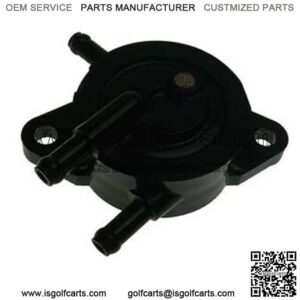How Does a Golf Cart Fuel Pump Work?
A golf cart pump has a simple design and is smaller than fuel pumps in other vehicles. It is a vacuum-powered pump that uses pressure from the crankcase. This pressure is called pulse and is generated at the bottom of a piston in the cart when the crankcase turns.
When the diaphragms start pulsing, the fuel is moved from the gas tank to the inlet chamber. From here, the fuel gets transferred to the outlet chamber and then to the other parts of the engine.
Can you Put an Electric Fuel Pump on a Golf Cart?
Yes, it’s possible to install an electric fuel pump on a golf cart. The fuel pump must be powered from that side of the solenoid, which features the starter motor.
In other words, it must be connected from the large post of the solenoid that goes towards the starter. This ensures that the pump operates only when the starter gets running.
Keep the vacuum line plugged off. Also, keep the fuel pump off the battery until it’s primed completely.
Why Does My Fuel Filter Stay Empty?
The fuel filter of the golf cart is designed in such a way that the motor operation does not get affected when the fuel filter is half full.
If the fuel tank of an EZGO golf cart is empty, there is likely to be a problem in the vacuum tube that connects the crankcase and the fuel pump. The tube may either be completely damaged or have just a hairline crack that drains off the fuel.
Consider replacing this tube. Also, check to see that no other tubes connected to the fuel pump are cracked. The clamps on all the connections must also be intact.
If the fuel filter of a Yamaha golf cart is empty, disconnect the fuel line coming from the carburetor followed by a turnover of the motor. This should release a stream of fuel. After this, consider pulling the vent out and sucking through it. This will help to clear blocks in the vent if any.
Types of Fuel Pump Problems
Deterioration of rubber fuel and vacuum lines
- Check for gasoline smell from the fuel and vacuum lines. Often, very small damages or pinholes are not visible. This is why checking for the smell is very important.
- Replace the rubber line from which the smell emanates.
Debris buildup
- Remove the fuel pump from the golf cart and take out each component. Although an inline fuel filter helps in controlling the debris buildup, some debris inevitably gets accumulated over time.
- Clean each component using a cleaner or gas specifically intended for this purpose.
- Assemble the fuel pump once again.
- Fix it back in its original place in the golf cart.
Fuel breakdown due to long-term storage
- Unhook the gas lines from the golf cart.
- Drain the fuel inside the fuel pump into an approved gasoline storage container.
- Empty the contents of the carburetor. You can use this chance to clean the carburetor inlet.
Engine problem
- Check for a damaged engine or a leaky crankcase that limits the power production. You might also look out for problems with the case gasket, a faulty crankshaft seal or oil leak.
- Replace the worn-out part or parts after confirming that they’re beyond repair. If a part can be repaired, you can try doing that first.
- If there is an oil leak, take the cart to the service personnel for their assistance in fixing the problem.
Ethanol Mix
- Opt to buy fuel from stores that sell pure gasoline without traces of Ethanol. This is slightly expensive but a cheaper deal compared to when you have to replace damaged parts because of the rust deposits that occur in the fuel supply.
- Get a fuel stabilizer fitted for the smooth running of the golf cart engine.
- Ensure that the engine is completely dry before you store it for a long time when the season ends.
Clogged fuel pump
- Remove the bolts of the fuel pump.
- Take the fuel filter and diaphragms out without damaging them.
- Clean the other parts of the pump, especially the tank and cap vents as they tend to get clogged.
- Reassemble the pump and ensure that it’s placed in position properly.
Diaphragm damage
- Disassemble the fuel pump and take each component apart.
- Replace the broken or torn diaphragms using a rebuild kit. The reason for the damage is often due toa lack of maintenance or extensive use.
- Assemble the fuel pump and place it back in its original position.
Vapor lock
- Connect a marine primer bulb in between the fuel pump and the fuel tank.
- Pump the bulb for a while till the carburetor is loaded fully with fuel.
- Start the engine and check if it continues running without the priming action. If it does, there is a vapor lock.
- Replace the existing hose from the fuel tank to the filter with a slightly larger hose. This ensures that the filter is never dry and has some fuel always, which in turn prevents vapor lock.
How to Test a Fuel Pump on a Golf Cart
- Check the vacuum and fuel lines if the carburetor fails to get sufficient fuel. These lines are made of rubber and tend to deteriorate over time. Gas leaks or gas odors are signs of faulty fuel lines. A damaged vacuum line has a drastic effect on the fuel pressure as the power of the vacuum gets lost. This causes excess air to be sucked in. Often, the vacuum line may have very minute damage in it that is not visible outside.
- Like a gas leak, the golf cart fuel pump should also be tested for oil leaks in the lower part of the engine or crankcase. This usually happens because of a defective case gasket or crankshaft seal. It’s recommended that you take the assistance of service personnel to resolve the problem as it needs expertise.
- Check if the fuel pump has an accumulation of debris, dirt or other contaminants. Although an inline fuel filter between the pump and tank keeps most of these elements at bay, some contaminants may still make their way inside. To get rid of them, remove the pump from the cart and disassemble it. Often, there will be just three sections separated by two diaphragms.
To make the re-assembly easy after cleaning, draw a line across the sections.
- Inspect the diaphragms for tears or damage. These are generally fragile thin plastic sheets. If you find any problem, do a replacement with a rebuild kit. To check the diaphragms, you will have to dismantle the fuel pump as mentioned above.
How to Install a Fuel Pump on a Golf Cart
In a Yamaha G9 golf cart, the pulsar line or the outer hose outlet must face downwards.
In an EZGO golf cart, the installation is in the following order.
- Gasket
- Spacer
- Rubber O ring
- Fuel pump
“Keyword”
“golf cart fuel pump diagram”
“golf cart fuel pump test”

